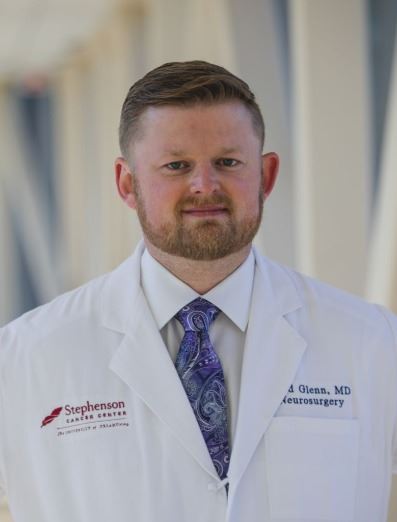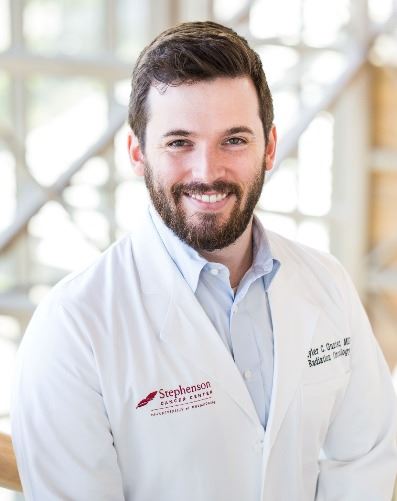OU Health Stephenson Cancer Center Performs First Brachytherapy, Implanting Radioactive ‘Seeds’ Around Tumor Site
- Category: News
- Posted On:

An OU Health Stephenson Cancer Center surgical and medical team has performed its first brachytherapy procedure for brain tumor, a process in which radioactive “seeds” are implanted around the edges of the tumor site after it has been removed.
The surgery, the first known case in Oklahoma, treats the cancer internally, rather than from an outside radiation source. It is an especially good option for patients whose cancer has been treated with multiple courses of radiation therapy. Radiation therapy has a cumulative toxic effect on nearby tissue, making repeated treatments risky.
 “The benefit of brachytherapy is that it allows us to be very precise with the radiation dose,” said Stephenson Cancer Center neurosurgeon Chad Glenn, M.D., who performed the surgery and implanted the radiation seeds. “Although traditional radiation therapy is accurate and targeted, it can still spread to adjacent brain tissues or the scalp. Brachytherapy allows us to give a therapeutic dose of radiation but minimize the spread.”
“The benefit of brachytherapy is that it allows us to be very precise with the radiation dose,” said Stephenson Cancer Center neurosurgeon Chad Glenn, M.D., who performed the surgery and implanted the radiation seeds. “Although traditional radiation therapy is accurate and targeted, it can still spread to adjacent brain tissues or the scalp. Brachytherapy allows us to give a therapeutic dose of radiation but minimize the spread.”
 Both the tumor removal and the implanting of the radioactive seeds are performed during the same procedure. Because the radioactive seeds have a short half-life, meticulous planning was necessary to ensure they were ordered, delivered and implanted at the correct time. Glenn’s colleague in Stephenson Cancer Center Radiation Oncology, Tyler Gunter, M.D., helped to plan the surgery, using an estimated model of the tumor cavity to calculate the radiation dose and number of seeds needed, as well as ideal placement.
Both the tumor removal and the implanting of the radioactive seeds are performed during the same procedure. Because the radioactive seeds have a short half-life, meticulous planning was necessary to ensure they were ordered, delivered and implanted at the correct time. Glenn’s colleague in Stephenson Cancer Center Radiation Oncology, Tyler Gunter, M.D., helped to plan the surgery, using an estimated model of the tumor cavity to calculate the radiation dose and number of seeds needed, as well as ideal placement.
“Brachytherapy is an ideal technique to deliver a therapeutic dose of radiation to brain tumors that have been heavily treated in the past,” Gunter said. “The dose to tumor cells adjacent to the sources is very high, while nearby uninvolved tissue receives a much lower dose, reducing the risk of side effects and complications. Because the dose near the seeds is so high, careful planning and placement is required to ensure a safe and effective treatment. The patient’s pre-treatment MRI is used to estimate the size of the area to be implanted with the radioactive seeds, and a computer program is used to determine the optimal spacing and to calculate the dose to the resection cavity and adjacent normal tissue.”
In the operating room, Glenn removed the tumor and sent a portion of it to pathologists to confirm it was malignant. Once that was verified, he began placing the radioactive seeds, which are similar to beads on a string, each about the size of a grain of rice. Glenn lined the edges of the tumor cavity with the seeds, maintaining an even spacing of a centimeter between each. The implanted seeds are considered permanent – they deliver radiation at decreasing doses over about three months, like a time-release capsule, then become inert.
“The patient is actually receiving treatment in the recovery room,” Glenn said. “Normally, patients who have a brain tumor removed will receive treatment in three or four weeks once they’ve healed. This allows us to treat someone immediately.”
Stephenson Cancer Center’s inaugural patient for brachytherapy was Hobart resident Josh Heard, whose brain tumor recurred after several previous treatments and surgeries. Heard didn’t get sick from the treatment, nor did he lose his hair. “There were many benefits to brachytherapy,” his mother, Terri Corbin, said. “We hope many more people benefit from it. Dr. Glenn is such a fantastic doctor, and everyone at Stephenson Cancer Center has gone out of their way to help us.”
The radioactive seeds, called Cesium-131, or commercially known as Cesium Blu, are produced by the company Isoray. It is the world’s only producer of Cesium-131 brachytherapy seeds.
“It is very exciting to see the important step forward that Stephenson Cancer Center’s Dr. Glenn and Dr. Gunter have made in making this leading-edge targeted internal radiation treatment available to their patients who are battling this difficult cancer,” said Isoray CEO Lori Woods. “We continue to strive to bring new brachytherapy treatment opportunities to the forefront to benefit patients and the medical professionals who care for them.”


.png)
